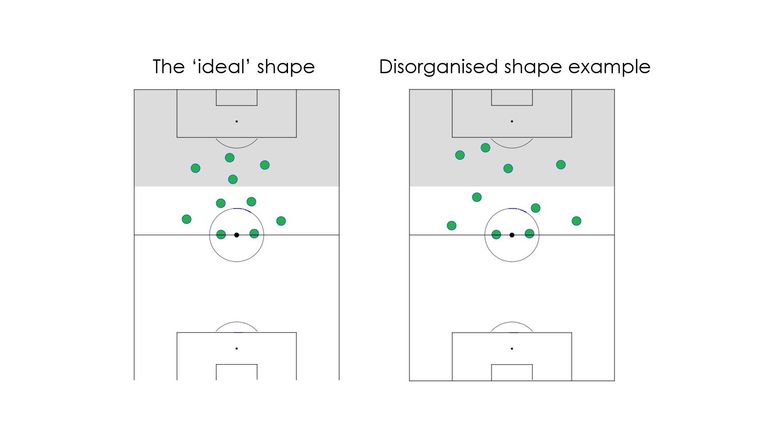MNF Extra: Players' off-the-ball movement could now be measured
Exploring the new metric that could tell us more about the game

Friday 17 April 2020 09:17, UK
In football, there are always those players whose contributions can be harder to measure.
When Gareth Southgate praises Jesse Lingard for his ability to "recognise space" and Michael Carrick calls his off-the-ball movement his greatest asset, the temptation is to be sceptical. Attacking players are judged by goals and assists, not their off-the-ball running.
Georginio Wijnaldum, the Liverpool midfielder, is another whose selfless running is not always reflected in his goal output. He did earn praise for his fine chip against Bournemouth last time out, a chance that came after another well-timed run into the box, but how many times does he not receive the ball? How many times does that run open space for others?
It is work that is often missed. Certainly, it can be harder for coaches and analysts to quantify the impact of those actions off the ball. Until now.
At the OptaPro Analytics Forum in London earlier this month, Mladen Sormaz and Dan Nichol presented their ground-breaking work on the subject of off-the-ball movement to an audience of analytics experts from within the football industry.
The pair met while stacking shelves at Asda but both went on to do PhDs, Sormaz studying neuroscience at York and Nichol doing computer science at Oxford. Their subsequent research together could now solve the problem of exploring off-the-ball movement - perhaps the final frontier of football analytics. "It's the wild west," Sormaz tells Sky Sports.
"With Opta data, it's kind of like listening to football on the radio. You get the main events and a sense of where they are happening on the pitch. But when you add the tracking of players you are adding so much more data because you have it down to every millisecond. You get the position of every player and so you can build a much more detailed view.
"Once you have all that stuff, we realised something - why are you never measuring what is happening off the ball? Whenever you hear Jamie Carragher doing analysis, most of the time he is talking about the players who don't have the ball and how they are reacting. So we tried to find some ideas in maths and physics that could help us measure that."
The starting point was to establish the ideal defensive shape of a team when the opposition has the ball. From there, it is possible to scientifically measure how much they are then disorganised from that shape. Sormaz and Nichol effectively calculated the shape damage to the defensive team that is created by the movement of the attacking team.
What they discovered is that space creating and formation damaging runs are more likely to lead to shots. That makes sense. But what is really interesting is the ability to identify those high-quality runs that disorganise an opponent's shape even if they do not lead to shots.
As a result, their work allows us to measure the quality of off-the-ball runs based on what they do to the opposition's ideal tactical plan. Which teams can be hurt most by off-the-ball movement? Which players are best at it? That knowledge could be a powerful tool for clubs because it could help them identify traits that are currently being missed in the statistics.
"We called it the Jamie Vardy problem," says Sormaz, "because when you think about the way he plays it's about running onto the ball. Once he has got it you don't really want him having too many touches, he needs to be one on one or to be able to play someone else in.
"He doesn't have a lot of touches but if you'd had tracking data from his time at Fleetwood could we have picked something up beyond the traditional stats by looking at his runs?
"The other idea was to apply it to Raheem Sterling. Before he started banging them in for City, he sometimes looked ineffective towards the end of his time at Liverpool but that was because he was always drawing two men towards him. He would carry the ball, draw men to him, then play what looks like a simple ball. There is probably some hidden metric there."
The hope now is that this metric is hidden no more.
There is a lot of work still to do before it becomes commonplace. Sormaz and Nichol only researched the games of one team in La Liga for one season. "One match in its raw form is like downloading a film off iPlayer," Sormaz explains. "If you are trying to do that over a season, 10 matches a weekend, you need a huge database."
The good news is that the appetite is there and the feedback has been good with national football federations and several Premier League clubs already preparing to explore the idea in more depth. In addition to his role as a data scientist with Football Whispers, Sormaz now works part-time for Huddersfield Town so expect them to be keen to do the same.
"Usually, stats stuff is in a bit of a vacuum but ours is quite applied so people from clubs seem to enjoy it," adds Sormaz. "We want to be able to tell coaches something useful rather than what they already know put through a metric. We want to be able to show them that this team doesn't react well to what players do off the ball so you might want to do this."
It isn't so long ago that talking about the concept of assists raised eyebrows. Now it is customary for key passes and dribbles to be discussed in the mainstream, while the use of expected goals is already old hat in analytics circles. Teasing out off-the-ball movement from the data could be the next step. Its best exponents might not be underrated much longer.








